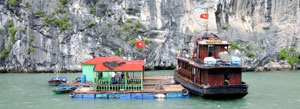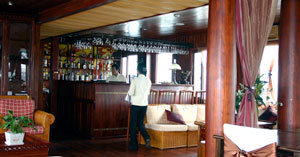HALONG BAY, VIETNAM - Our journey to the land of the “stone dragons” began on a disappointing note one clear autumn morning.
“There’s a typhoon developing in the South China Sea and our plans will have to change. The central (Vietnamese) government will only allow boats out on Halong Bay for three hours; all overnight cruises are cancelled,” our guide Dinh told us.
Our hope of spending a romantic night aboard a traditional junk - refurbished with all the modern conveniences, of course - sailing around the 3,000-plus limestone islets that jut out of the lovely bay like stone dragons, was in jeopardy.
Dinh offered us a choice: “Stay in Hanoi (which meant missing Halong Bay altogether as our time in the area was running short) or drive there, sail for three hours and if the weather does not change, then spend the night at a local hotel before returning to Hanoi.”
Even three hours on legendary Halong Bay, we decided, was better than not seeing the UNESCO World Heritage Site that is one of Viet Nam’s greatest attractions. And besides, the three-hour drive, Dinh promised, would introduce us to Viet Nam’s rural lifetsyle and “some interesting sights.”
Soon afterwards, Dinh was manoeuvring his small van through Hanoi’s motor scooter-congested streets; past the Long Bien Bridge, a favourite target of U.S. B-52 bombers during the Viet Nam War - the weakened bridge can only hold pedestrian traffic now - heading in the direction of Hwy. 5, the main route to Halong Bay.

Above: The UNESCO-protected Bay is always crowded with traditional junks and tourist ships.
On the other side of the Red River, the coffee-coloured waterway that cuts Hanoi in half, we entered an area Dinh said was known locally as “the happy hour” - a part of the city filled with cheap hotels where, he explained, “couples come during their lunch hour to have sex.”
As we turned onto Hwy. 5, Dinh revealed, “every day, five or six people are killed on this road.”
We soon understood why.
The narrow highway, which links Hanoi with Halong Bay and connects with Hwy. 1, the main route to the Chinese border, was crowded with local farmers and villagers riding motor scooters and bicycles, all overloaded with goods that seriously restricted the driver’s visibility. Some of the noisy scooters even had live pigs and small cows strapped on the back. They jostled for position with huge, fast-moving trucks carrying Chinese goods into the Vietnamese capital.
“Most of these truck drivers are smugglers,” said Dinh while swerving to avoid one.
“Tofu brain,” shouted our driver at the passing trucker.
The country’s mid-autumn festival was in full swing during our visit and each of the villages we passed was busily preparing for celebrations later in the week. Local markets were decked out with brightly-coloured balloons - the mid-autumn festival tends to favour children - and extra rice was being harvested for large family gatherings in neatly kept fields outside each village.
We couldn’t help but notice that a portion of the rice fields also served as a graveyard.
“We live with the rice, so when we die, we lie with the rice,” explained the guide of the richly decorated family tombs that stand out against vibrant green backdrops.
Rice, coffee and bananas are Viet Nam’s biggest exports but each is harvested using ancient techniques. Modern farm equipment is in short supply in this developing country so water buffalo and makeshift tractors Dinh called “the Vietnamese Land Cruiser” help harvest and transport crops.
“Our Land Cruiser is made up of discarded parts,” said Dinh. “The wheels are from old Russian cars; the engines are from old Chinese trucks.”
They may be the ugliest vehicles you ever see - but they get the job done.
The lush countryside was dotted with brightly-coloured homes, traditional types that tend to be narrow (most are no wider than 10 feet), three or four story buildings. The first story is always devoted to the family business while the rest is used for living space.
About an hour into the drive - we were now traveling on Hwy. 1 - Dinh pulled off the road and into a factory parking lot filled with tourist coaches. He suggested this was where we could stretch our legs and “meet the victims of war.”
The Truth, Beneficence and Beauty Company was built as a rehabilitation centre for those affected by Agent Orange, the devastating chemical sprayed by American planes during the Viet Nam War that was intended to strip jungle foliage and expose enemy fighters.
The horrifying side effects of that blistering chemical were now staring at us - hundreds of disfigured children and young adults.
A blind woman touched me on the shoulder and offered to be my “guide” around the factory where people with genetic deformities were huddled at work stations producing products ranging from intricate jewellery to beautiful lacquer paintings. More than 30 years after the war, over one million Vietnamese still suffer disabilities linked to Agent Orange but this factory helps them “lead a normal life,” the blind girl told me.
After a moving hour at the Truth factory, where we filled our cart with all kinds of beautiful crafts - guilt-ridden westerners tend to over purchase here - we resumed our journey to Halong Bay.
The road took us deep into the country’s heartland; through coal mining towns where rain water ran black down dusty streets; past roadside stands selling miniature pineapples (very sweet); and to the entrance of a restaurant called “dhij cho.”
“Westerners are not always willing to eat in these restaurants,” Dinh told us.
That brought a quick “why!?” from us.
“They feature dishes made of dog,” he replied.
“You mean, all those dogs we saw bundled on the back of motor scooters earlier today weren’t going to good homes?” we asked in astonishment.
“No,” replied Dinh, “they were going to good restaurants.”
Suddenly, we lost our apatite.
In the next farming village, a wedding was being celebrated.
“In Viet Nam, the engagement ceremony is held in the morning and the wedding ceremony in the afternoon,” the guide informed us.
The Vietnamese obviously don’t believe in wasting time.
Just outside the village, a convoy of motor coaches were stopped on the side of Hwy. 1; their occupants snapping photographs of workers harvesting rice. The workers shyly soaked up all the attention.
A side trip down a pathway leading off the main highway led us to a small farmhouse where four women invited us into their open kitchen for a cup of tea. The sight of their images in my digital camera evoked lots of shy giggles.
Along the way, we also passed a number of ceramic villages where pottery has been made for centuries - Vietnamese ceramics have always been held in high esteem.
“On our return trip from Halong Bay tomorrow, we will stop at Bat Trang, the most famous pottery village in all of Viet Nam,” said Dinh of a place where villagers have been making ceramics for over 700 years.
Halong and its famous bay were being drenched in heavy rain when we arrived just shortly before noon. Dinh dropped us off at the town’s busy dock and a small launch ferried us to the anchored Halong Ginger, the most beautiful of all the junks that sail here.
The crew hurriedly prepared the vessel for departure as winds from the fast-approaching typhoon began seeping into the normally tranquil bay. Through rain and mist, the silhouetted “stone dragons” began to appear.
Legend has it that the thousands of limestone islands, each topped with thick vegetation, were formed when a ruler sent a family of dragons to fight off some foreign invaders. The dragons began spitting jewels at the advancing army and when the diamonds and jade hit the water, they turned into islands that presented the foreigners with a formidable fortress.
Geologists estimate the bay and its islands were formed around 5000 BC by natural forces. Many were left hollow and their cavities now serve as adventure stops for tourists. The largest of Halong Bay’s caves is Wooden Stakes, which was originally called Grotte des Merveilles by 19th century French explorers. Wooden Stakes features three large chambers containing numerous stalactites and stalagmites as well as 19th century French graffiti. Two bigger islands, Tuan Chau and Cat Ba have permanent inhabitants and offer tourist facilities like hotels and beaches.


Above: People of the bay live on boats tied together while tourists are spoiled like royalty.
The favourite activity of tourists visiting Halong Bay, though, is to sail lazily through the islands on an overnight cruise aboard one of the refurbished junks; jumping into the crystal-clear surf to swim and snorkel, or trekking through island caves - something we had been planning for over a year. The typhoon blew our hopes.
So after sailing for almost four hours, hoping the weather would change in our favour, our hearts sank when the captain finally announced he had been ordered to turn back to port.
The evening was spent visiting the souvenir shops of tiny Halong, a resort town surrounded by dramatic landscape and the UNESCO bay, and building up our courage for the return drive to Hanoi.